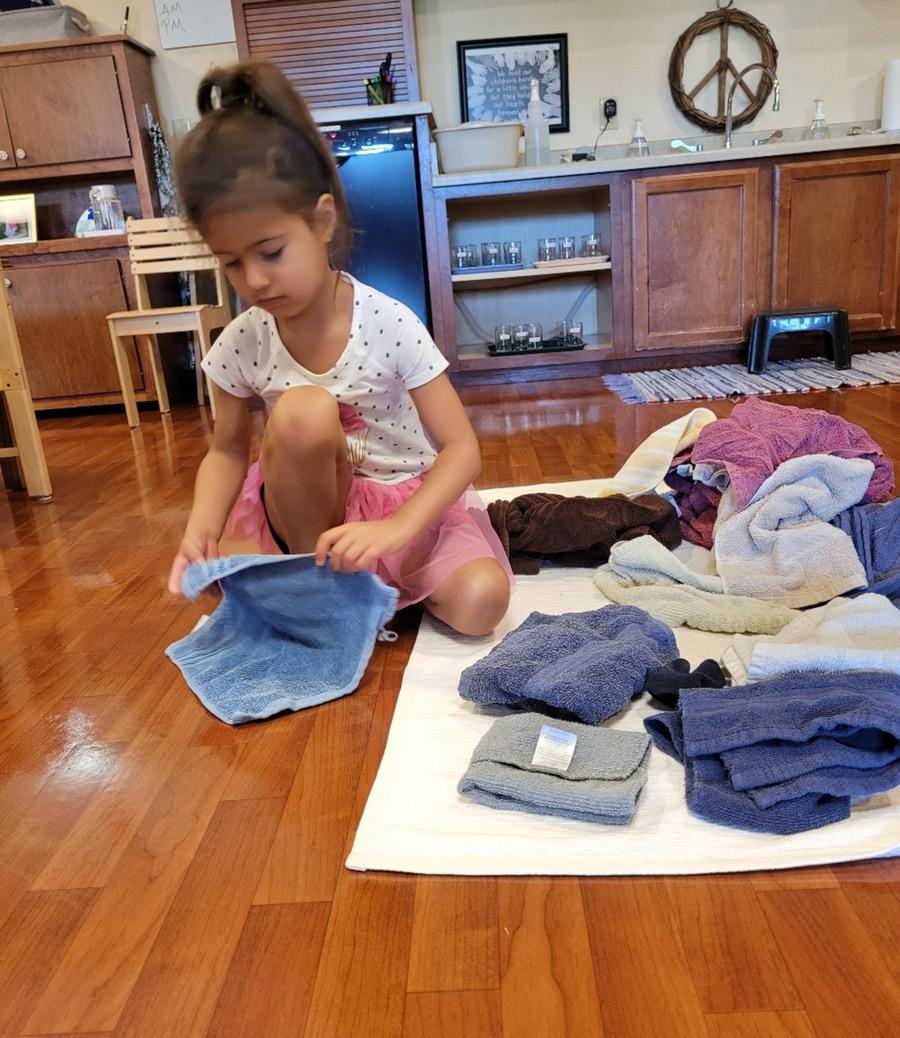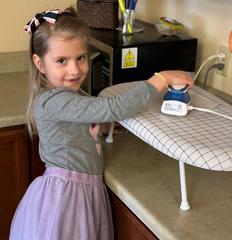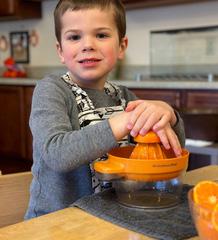AT HOME WITH MONTESSORI





Montessori isn’t just for the classroom. You can easily bring its principles into your home—and doing so can be an invaluable bridge to reinforcing what your child learns at school.
"We must give the child an environment that he can utilize by himself: a little washstand of his own, a bureau with drawers he can open, objects of common use that he can operate, a small bed in which he can sleep at night under an attractive blanket he can fold and spread by himself. We must give him an environment in which he can live and play; then we will see him work all day with his hands and wait impatiently to undress himself and lay himself down on his own bed."

–Maria Montessori
"To assist a child, we must provide him with an environment which will enable him to develop freely." Maria Montessori
A prepared environment includes both the people and the physical surroundings. The prepared environment will include family, friends, order, and materials that foster optimal developmental growth with independent learning and interdependent living.


His or her environment affects everyone at every age: especially the developing child. All human beings, from conception to maturity, form themselves through their environment. Adults and children with the habits of organizing and being in an organized environment will often enjoy better mental health, efficiency, creative thought, and peace.
We live in a world made for adults. If we, the adults, had to live just one day in an environment we traditionally give our children, we would find it painfully uncomfortable. We would tire greatly, as we would expend all of our energy defending ourselves. Children do this. Children should never have to do this!
One of the most important elements of the prepared environment is that of respecting the concentration of the child. When the child is engaged in an activity that is safe and purposeful, requiring the effort of both their mind and body, it is the adult’s role to respect and protect it. Gradually, children in a prepared environment reveal qualities for which they are not usually given credit, such as, intense concentration and a surprisingly long attention span, exact and precise movements, a sense of order, peaceful, maximum effort, self-discipline, a love for work, and respect for others.
The adult model is always the most important element in the environment, as we are the keepers of the environment, the tone setters. Children learn by observing and interacting in their environment, including that which the adult does.

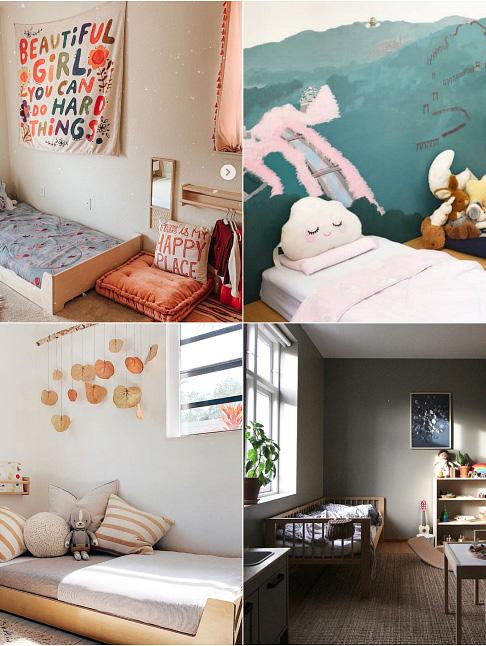
Activities
Reading books
Dressing and Undressing
Hanging up clothes
Folding clothes
Making the bed
Activities placed on low shelves
Putting soiled clothes in laundry basket
One of the most important and personal environments for your child is his bedroom. It is just that, his. Everything in your child’s bedroom should be purposeful, useable, and his. In addition, his bedroom should be structured, safe, warm, inviting, real, simplistic, clean, beautiful, orderly, and uncluttered. The bedroom should be designed for maximum independence. Independence refers to your child’s natural need and desire to do for himself and yet not be separate from you or others. His bedroom should include, child sized furniture, such as a small, low bed, low hooks, low clothes hanging rods, drawers and baskets, and low shelves for clothes, work, and toys. His bedroom should reflect his natural personality and current interests, not the latest trends or parents interests. Respecting his space by knocking first before entering is important for the child to feel ownership of his room. Most of all, his room must be safe and peaceful.

Suggested Items
Low shelves for works and toys
Family pictures hung low
Low child size table and chairs
Space for the child to hang artwork
Wastebasket
Low hooks for personal items
Face Clock
Low clothes rods
Low bed
Tissues
Laundry basket
Vase of flowers
Low chest of drawers/baskets for personal items or clothes
“The essence of independence is to be able to do something for one’s self.” Maria Montessori


A small inexpensive bookshelf can be used with plastic bins to hold a toothbrush, toothpaste, comb and brush. Extra towels and washcloths can be placed in attractive baskets or folded and placed on the shelf. Provide a step stool sturdy enough to allow your child to stand and reach faucet handles, access to the toilet, and soap to wash hands. Place a small basket with face cloths in the bathroom to allow your child to clean his face and hands after meals. Make sure the mirror is at his height to see his face.
Activities
Care of Self
Brushing Teeth
Brushing/Combing Hair
Washing Hands
Washing Face
Suggested Items:
A laundry basket provides your child a place to put soiled clothing, towels, and washcloths. Installing a towel holder at your child’s height is an inexpensive way to allow him to successfully dry his hands and provides a place to hang wet towels and belongings.
If your child is unable to reach the toilet paper holder, try using a standing floor version that can be moved closer to the toilet for him to more easily access.
A hand held shower attachment allows your child to successfully wash himself in the shower without water spraying in his eyes.
Care of Environment
Throwing Away Trash
Cleaning Spills and Sink
Laundering Soiled Items
Toileting
Small Shelf Plastic Bins Baskets
Toothbrush Toothpaste Comb
Brush Towels Washcloths
Wastebasket Step Stool
Towel Holder
Tissues Hand Soap Laundry Basket
For the Pantry
Save some of the lower shelves for your child. These shelves would include prepacked snacks – raisins, crackers, dry cereal, etc. These items can be purchased pre-packaged or you can pack them yourself in containers with a serving suitable to a child. Arrange them neatly on the shelf using a basket or similar container. When your child is hungry, he will know where to go for a quick snack. In the pantry you can also store essential items for your child to clean up. These items could include napkins, paper towels, a dustpan, and broom.
All children love to help in the kitchen; they just need a few items to be successful. One item that can help your child feel like a part of the kitchen is a child-sized apron. Your child can wear this anytime when he is working and helping in the kitchen. Other items your child can use in the kitchen include a serrated knife, a small cutting board, an apple slicer, mixing bowls, and small spatulas. All of these items can be on a low shelf in the kitchen that your child can access. Furthermore, fruits and vegetables can be stored in a bin in the refrigerator that your child can also access. Children can learn very early

Packaged Snacks Serrated Knife
Baskets
Paper Towels
Mixing Bowls
Cutting Board
Apple Slicer
Utensils
Spatulas Small Glasses
Stepstool Small Table & Chair
Small Pitcher
Placemat
Napkins
Dustpan & Broom
Apron
how to handle a knife safely and how to cut up fruit and vegetables. They can also help with baking if provided with the appropriate tools that are small enough to fit in their hands, but sturdy enough to do the job. Another important thing to consider is the height of the counters. As in most homes, they are made with the adult in mind. So, it’s important to have a sturdy stepstool or small table and chair that would be suitable for your child to work at. The stepstool could also come in handy for when your child wants to work at the stove, with adult supervision, or for when your child needs to do something at the sink.
For the Table
Your child should have access to a small pitcher filled with juice, milk, or even water. There should also be small glasses available for him to use within reach on a low shelf in the kitchen. Your child should have a placemat and a supply of spoons, forks, and butter knives – child sized. Children take pride at being able to set their own table. Given appropriate tools, guidance, and patience, your child can be very successful and independent in the kitchen at home.

The living room’s purpose is to include all family members. Make a small corner in the living room just for your child. Include a low shelf. On the shelf, place baskets with work or books in them. You can rotate the work out when you see your child has an interest in something else or isn’t interested in what is on the shelf anymore. Place a child size comfortable chair or beanbag where the child can sit and look at books or just rest. Your child will often prefer to sit on the floor when doing work. Use a small basket to hold area rugs. Your child will use these rugs to designate his own space. Having music in the living room is a great way to release energy, develop tone and pitch and receive the brain stimulation needed for cognitive thinking. Other opportunities for the living room set up are care
Suggested Items:
Large Area for Gross Motor
Fire Place Screens
Quiet Area to Play or Dance
of the environment lessons, plant care, dusting, window washing, sweeping, and vacuuming. It is very important that your child be allowed to participate in the everyday life of the family. It is through this participation that crucial aspects of his personality and intellect will develop. As your child becomes skillful at carrying out everyday household tasks, he discovers the joy of learning and of purposeful activity. He feels that he too, has something useful to contribute to the family. Through working at and eventually mastering these tasks, he develops a sense of order or sequence; as he grows in independence and self-control, and his sense of self-respect is strengthened.
Plant Care
Make sure there are plenty
of plants throughout the house on your child’s level. Be careful that they are not poisonous. The plant care activity can be placed on a small tray or basket containing a small paintbrush for dusting leaves, a sponge for cleaning leaves, and a mister. Show your child how to carefully hold the leaves in his hand as he brushes it from stem to tip. Then wet the sponge and wipe each leaf clean. After that, mist the plant about three times. You can also show your child how to test the soil’s moisture with his finger and use a small watering can to water each plant.
Window Washing
You can set up this activity by putting a mister, squeegee, and washcloth in a small tray or basket. Allow your child to spray one spray of the mister then wipe the water away with the squeegee. Use the washcloth for any drips.
Low Shelf Books
Blanket Block
Stool to Get Up On the Couch Baskets
Quiet Place to Talk or Read Together
Child-Sized Chair Music



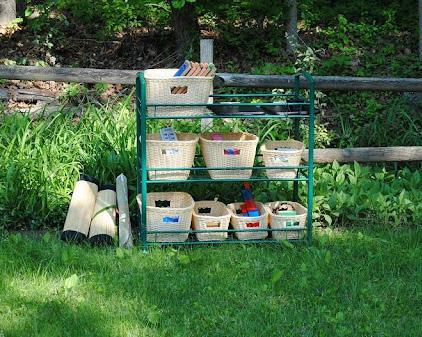


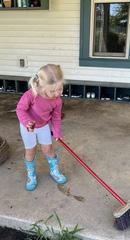
Setting Up the Environment
Continue the sense of order that has been created inside your home. A small inexpensive wire-shelving unit can be used with plastic bins to hold different items (chalk, jump ropes, bubbles, gardening tools, mud boots, etc.).
Activities
Care of Environment
Sweeping Porch or Sidewalk
Filling the Bird Feeder
Raking Leaves
Shoveling Snow
Washing the Car/Scrubbing Tires or Hubcaps
Gardening
Planting Seeds/Plants
Watering/Misting Plants
Weeding
Cutting Blooms for Flower Arranging

Cutting Back Plants for winter
Planting Bulbs in fall
Animal Care
Caring for animals can encourage responsibility in your child and also foster nurturing and a sense of compassion for other living things.
Feeding and watering
Cleaning Cages, Tanks, Other Environments
Suggested Items:
Small Shelf Plastic Bins
Gardening Gloves Rake
Push Broom Trowel
Dustpan and Brush Regular Broom
Hand Rake Snow Shovel
Scissors
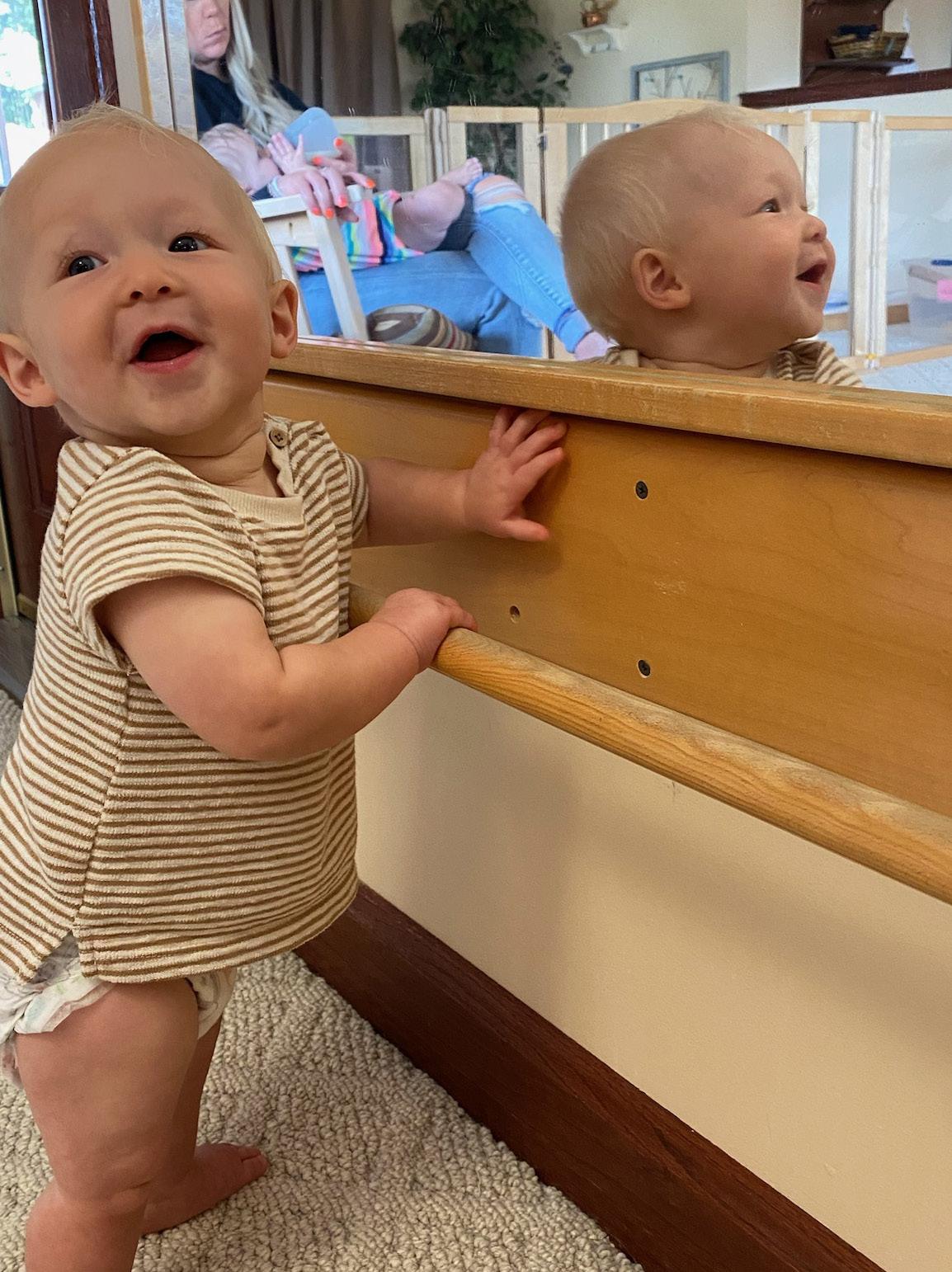
The Bedroom
While a traditional crib generally prevents your infant from leaving his bed, a Montessori floor bed allows your infant to enter and leave his bed without your assistance. When your infant is able to leave his bed independently he can explore and develop in a safe environment. When planning the décor of the room, sit at your infant’s level to see what he sees. Use the beauty of the world outside to stimulate your infant’s mind. As your infant begins to make choices about food and toys, also allow him to choose clothing to wear. Place appropriate choices in baskets on low shelves for him to access.
The Bathroom
Make the bathroom a part of your infant’s diaper changing routine as soon as possible.
If you have room, place a diaper-changing mat on the
bathroom floor instead of using a changing table in his bedroom. When your infant is able to stand securely, change him standing up. Allow him to undress independently as much as possible to prepare for when he will use the toilet on his own. Make sure to help wash his hands just as you would wash your own hands after each diaper change or toilet use.
The Kitchen
Nutrition begins at conception. You make sure to eat healthy while you are pregnant to keep your infant healthy. Continue this once your infant is born. A food processor, food mill, or blender will allow you to feed your infant the same food you eat once he starts eating around six months. Your infant will also begin sitting around this time. Have a small chair and table in your kitchen or dining area for him to eat at. A
small spoon, bowl, glass, and placemat will help him learn to feed himself.

The television should be off whenever the infant is in the room. Several studies on brain development speak to how harmful the television can be on your infant’s developing mind. A small shelf with only a few toys on it will allow your infant to explore and experiment without becoming overwhelmed. Although walkers, play pens, and swings may seem convenient and entertaining, imagine how frustrated you would feel without the opportunity to move freely throughout your environment. As your infant is able to explore he will learn to crawl, pull up, push around and walk behind both concrete objects, such as furniture, and push toys that allow greater movement.
Bringing your infant outdoors even before he is mobile can be a great learning experience for him. Keep an absorbent blanket handy to take outside and lay on the grass under a tree. The tree can be a natural mobile. As your infant grows and begins to explore the outdoor environment make
sure to think of safety by putting locked fences around pools or other bodies of water and making sure he does not ingest poisonous plants. Fun activities for your infant outside can include dishpans of water to splash around in, walking around on the grass, mulch, pavement, and other surfaces barefoot to feel texture, or even bringing the outdoors in with a bucket full of snow to explore.
Practical life is an area of the environment set up with necessary works of daily life: hand transferring, pouring, squeezing, spooning, rolling and folding, stringing, twisting, pounding, sweeping, scrubbing, polishing, washing dishes, setting table, care
of plants and animals, also food preparation along with courtesy and grace. When a child develops order, concentration, coordination and independence through the mastery of the practical life work in the environment, he or she will use these skills through out the other academic areas in the environment.
To aid the child in developing the skills he or she needs to become self-sufficient. Practical life is a very important part of the curriculum. To assist in the development of the child we keep the following aims in mind when setting up the environment: Order, Concentration, Coordination and Independence.


1. Physical Skills
• Spooning, hand transfer, squeezing, rolling, folding, twisting, stringing, pounding, and pouring with and without handles and spouts
2. Care of environment
• Sweeping, dusting, scrubbing, polishing, table setting, daily chores, care of plants and animals, outside environment
3. Care of self
• Hand washing, dressing frames, scrubbing, combing a wig, bathroom, dress-up
4. Grace and Courtesy
• This is where we reinforce a positive attitude and help children learn respect. This is vital in order to build a classroom community.
5. Nutrition and food
• Slice wooden fruit and vegetables, slice real fruit and vegetables, spreading
• Folding clothes and putting them away
• Setting the table-let the child help with the silverware, dishes, folding napkins

• Clearing the table- let the child help with the items that are lighter and not dangerous
• Drying dishes and silverware after washing
• Child size cleaning tools- broom, mop, duster, dustpan, brush, sponge
• Plants at his level- to water and take care of
• Making their own bed
• Cleaning windows with a sponge and towel
• Shelves or cabinets organized for certain toys, books, puzzles, dolls or trucks
• Cloths on a shelf that the child can reach- let them choose their own clothes and put them away
• Clothes he or she can get on and off by themselves- large buttons, elastic waist bands
• Wash hand, face, brush teeth on their own- place a stool to give them a lift to reach the faucet
• Wash clothes, towels, toothbrush, hairbrush all within reach so they can take care of themselves
• A mirror low enough for the child to check for cleanliness in appearance
• Answering the phone- teaching them proper phone manners
• Simple food preparation- let the child assist with mixing, stirring, slicing
• Low shelf in the refrigerator for the child to get their own snack
